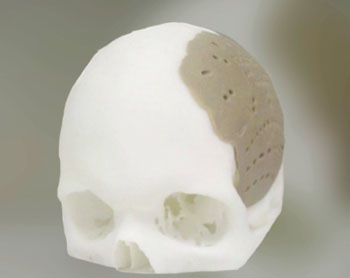3D-Printed Facial Implants Revolutionize Facial Reconstruction
By HospiMedica International staff writers
Posted on 08 Sep 2014
An innovative patient-specific three dimensional (3D) printed polymeric implant marks a new era in the standard of care for facial reconstruction.Posted on 08 Sep 2014
The OsteoFab patient-specific facial device (OPSFD) is a maxillofacial implant that is biocompatible, osteoconductive, mechanically similar to bone, and radiolucent. Designed using individualized magnetic resonance imaging (MRI) or computerized tomography (CT) digital image files, the OPSFD is produced using a combination of laser sintering high performance additive manufacturing (HPAM) technology and a proprietary high performance polymer powder formulation, poly-ether-ketone-ketone (PEKK).

Image: An OPSFD implant designed to reconstruct part of the cranium (Photo courtesy of OPM).
The technology allows not only accurate shape replication, but is also capable of meeting specific, anatomically applicable performance requirements through a proprietary "Coherent Implantology Process," in which implant fit, form, and bio-function are digitally calculated, constructed, and then produced. The OPSFD is a product of Oxford Performance Materials (OPM; South Windsor, CT, USA), and has been approved by the US Food and Drug Administration (FDA).
“An exciting aspect of our technology is that additional complexity does not increase manufacturing cost, and having both cranial and facial devices cleared now enables us to answer ever more complex cases where upper facial structures can be incorporated with cranial implants as a single device,” said Severine Zygmont, President of OPM Biomedical. “As a result, additive manufacturing has the potential to not only improve patient outcomes, but fundamentally improve the economics of orthopedics on a global scale.”
“There has been a substantial unmet need in personalized medicine for truly individualized— yet economical— solutions for facial reconstruction. Until now, a technology did not exist that could treat the highly complex anatomy of these demanding cases,” said Scott DeFelice, CEO and chairman of OPM. “With the clearance of our 3D printed facial device, we now have the ability to treat these extremely complex cases in a highly effective and economical way.”
Related Links:
Oxford Performance Materials














